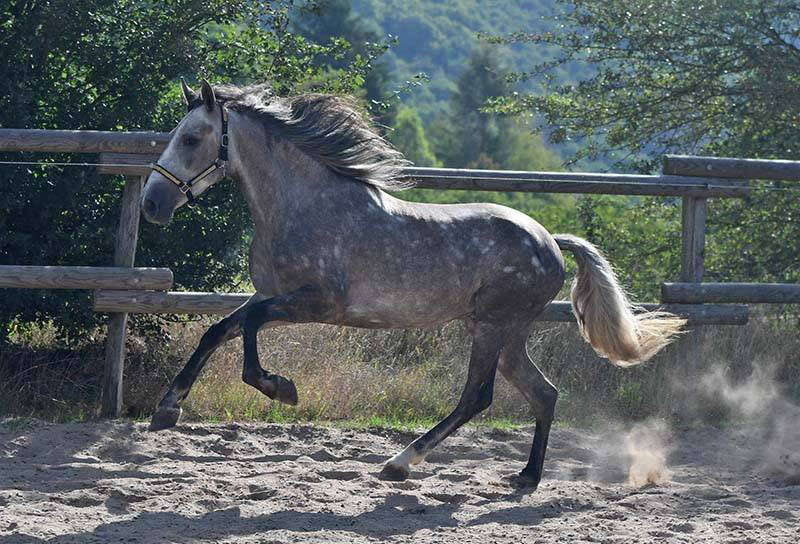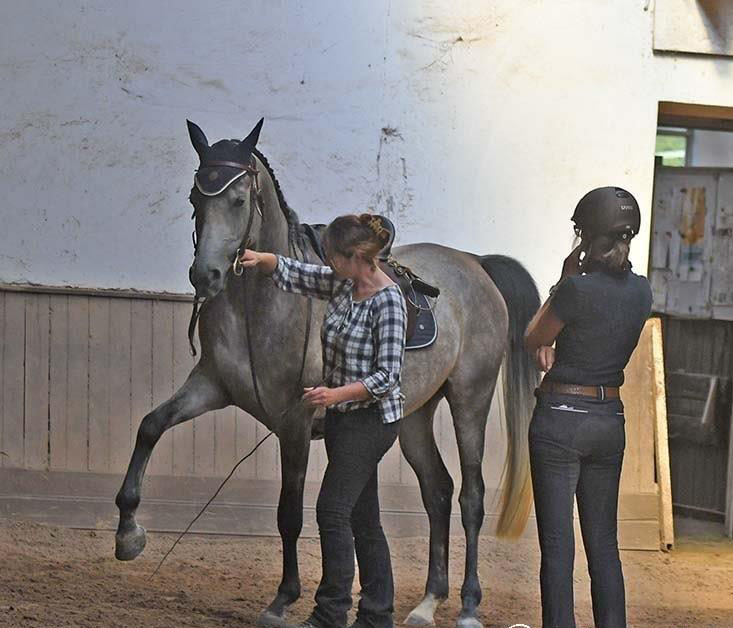As 2020 comes to a close, I think we can all agree that we are tired and ready for the new year. The air around us is dropping to winter temperatures and the animals in our lives are feeling the change.
While it might get you and your horse’s heart racing to start out on the lunge line fresh and frisky, it’s not going to help either of you in the long run! You want to get your horse’s mind engaged to work before you can reasonably ask them to work. Oftentimes, training your horse with mental stimulation can be more tiring than physical stimulation. When you’re starting to feel that your horse isn’t all there with you for your session today, you can start with engaging their brain.

As you plan to move your horse’s training plan into winter, how do you handle your horse’s changing behavior?
Stretching
You can use a carrot or small treat for this. Show your horse the treat or carrot and move to the left side of their body, near their shoulder. When they move their head and neck around to stretch to their shoulder, reward with a treat! You can do this to the right as well. Then you can add in stretching in between their front legs and stretching forward and down. Remember to start slow. This exercise is about getting their attention in the beginning. Once they learn it, you can incorporate it into every riding or lunging session!
Spanish Steps

You can teach your horse the Spanish Steps, or Spanish Walk! These are when your horse lifts their front feet high in the air before stepping down. You can start with yourself, your horse, a dressage whip, and lots of treats!
Start by tapping your horse’s front foot with either your hand or the whip, whichever your horse is most comfortable with. As soon as he lifts it up, praise with treats! You want him to learn that tapping his foot or leg means that you want him to lift it. Once he has that down with both feet, you can start to work with his steps as he walks. Encourage him forward, tap his foot, and see if he lifts it. It’s important to praise as soon as you see the behavior you want! Learning a new trick is a fun and relaxing way to engage your horse’s brain.
Confidence through Desensitization
Is your horse scared of the shovel sitting in the corner of the ring? Has he experienced walking through water? What about the scary hay bag that’s in his friend’s stall? You can start to inventory these items to work on later. It’s important to start slow and work with your horse before they spook at the item. So, if you are working towards desensitizing to the shovel in the corner of the ring, you want to start the exercise as you walk out of the barn. Keep treats with you! As you walk out to the ring, reward your horse for calm behavior: this looks like sniffing the ground, relaxing their head and neck, or blowing out of their nose. If you start to see that your horse is looking weirdly at the item, physically move away from it until they feel less threatened. This is an exercise that takes time but is ultimately a helpful tool for you and your horse. As you desensitize to things that your horse is scared of, you start to teach them both that you have the situation handled and that they can handle it themselves. This instills confidence in your horse’s brain leading to happier and more content horse and rider!
Teach “Touch”
If you have or train dogs, you might recognize this one! This helps your horse build their confidence by being intrigued by new items instead of reactive towards them. Start with something your horse likes to put their norse towards: a food bucket, your hand, their water bucket, etc. Point to the object. As soon as their nose touches the object, reward with a treat! You want to teach the behavior before you add the command. Once you can point and your horse will touch, add in “Touch”. It’s important to remember to use Touch only with things your horse isn’t already scared of – so that they don’t associate Touch with doing something that scares them.
Once you have the command solidified, you can start to use it for desensitization. This can be for things your horse is cautiously curious about. If they put their nose to it, great! They get a reward. If you feel that your horse is too scared to touch it, just like before, physically create distance between the item and your horse so that they are in a calmer state and able to re-focus on you.
Curious to Learn More?
Part 2 to this series is coming next week!
For a comprehensive lunging training guide, check out our:
